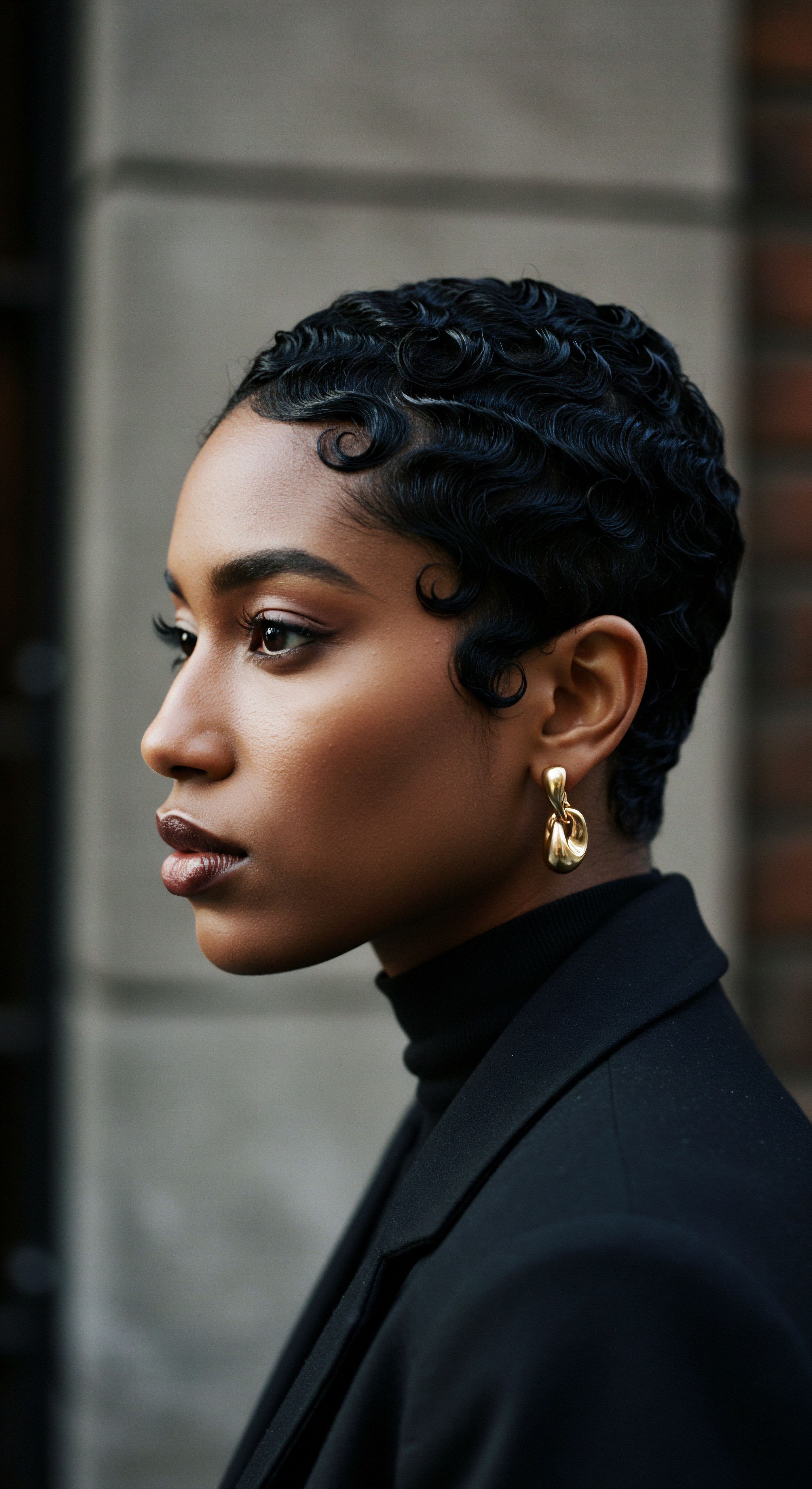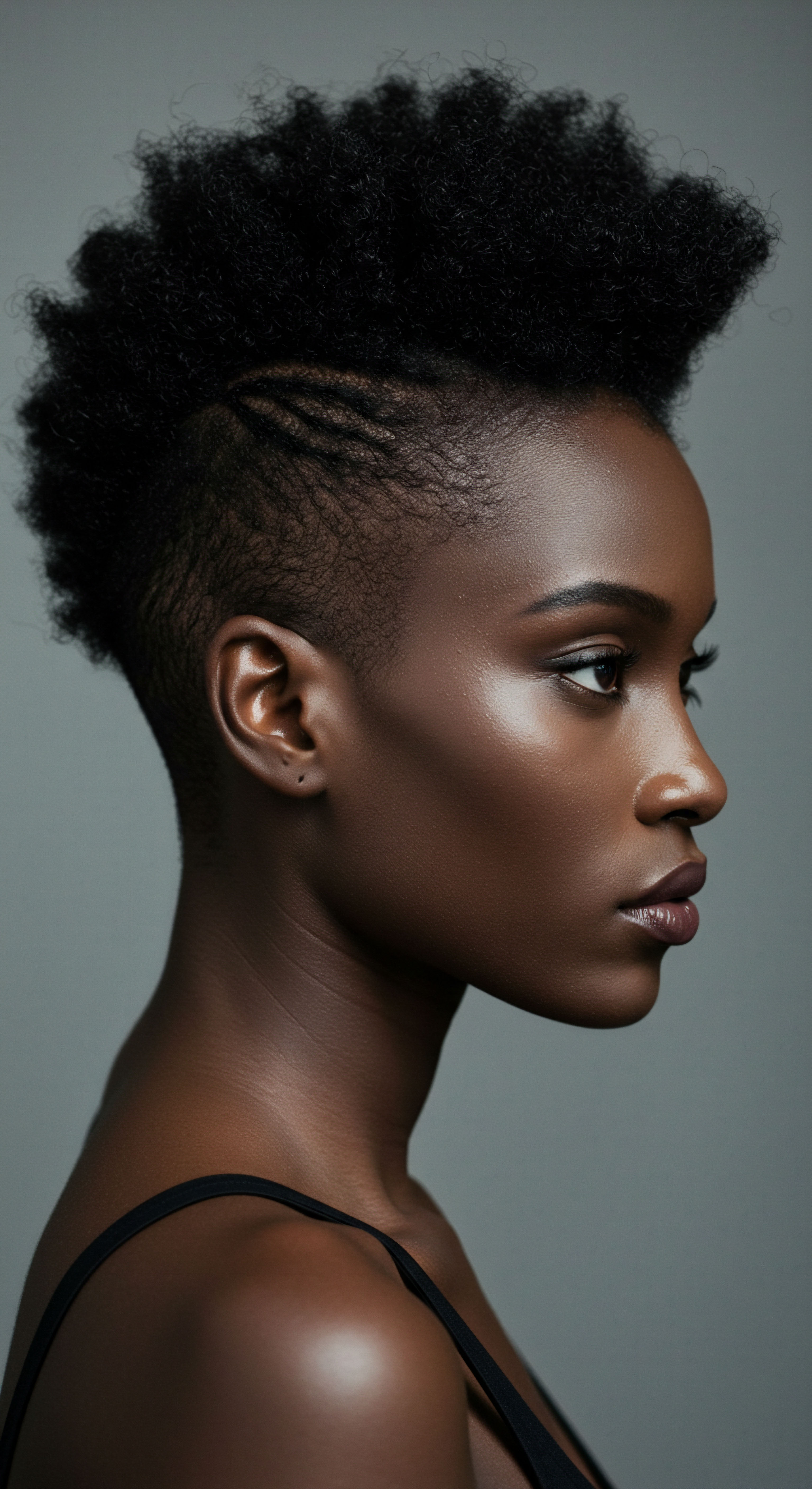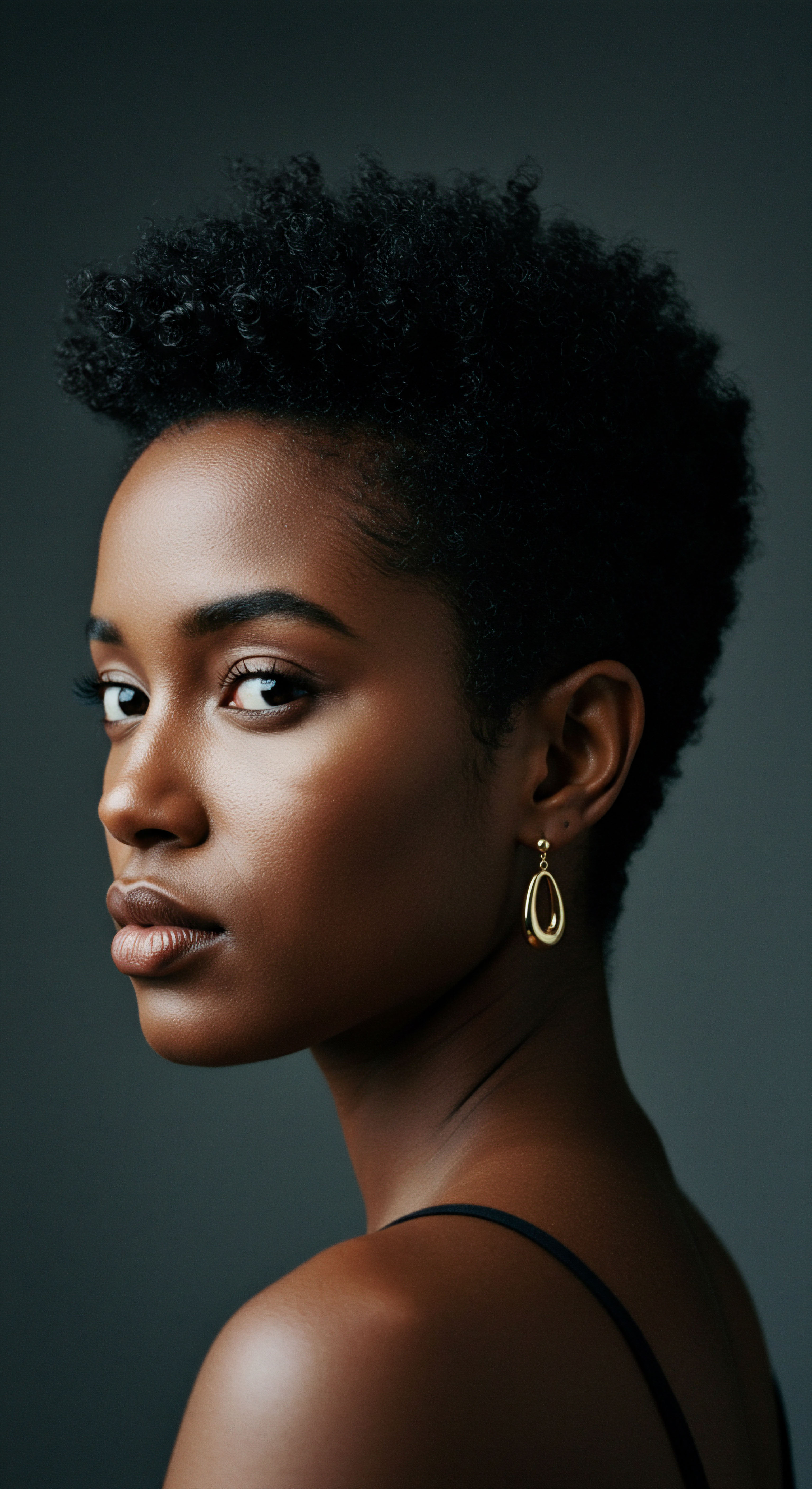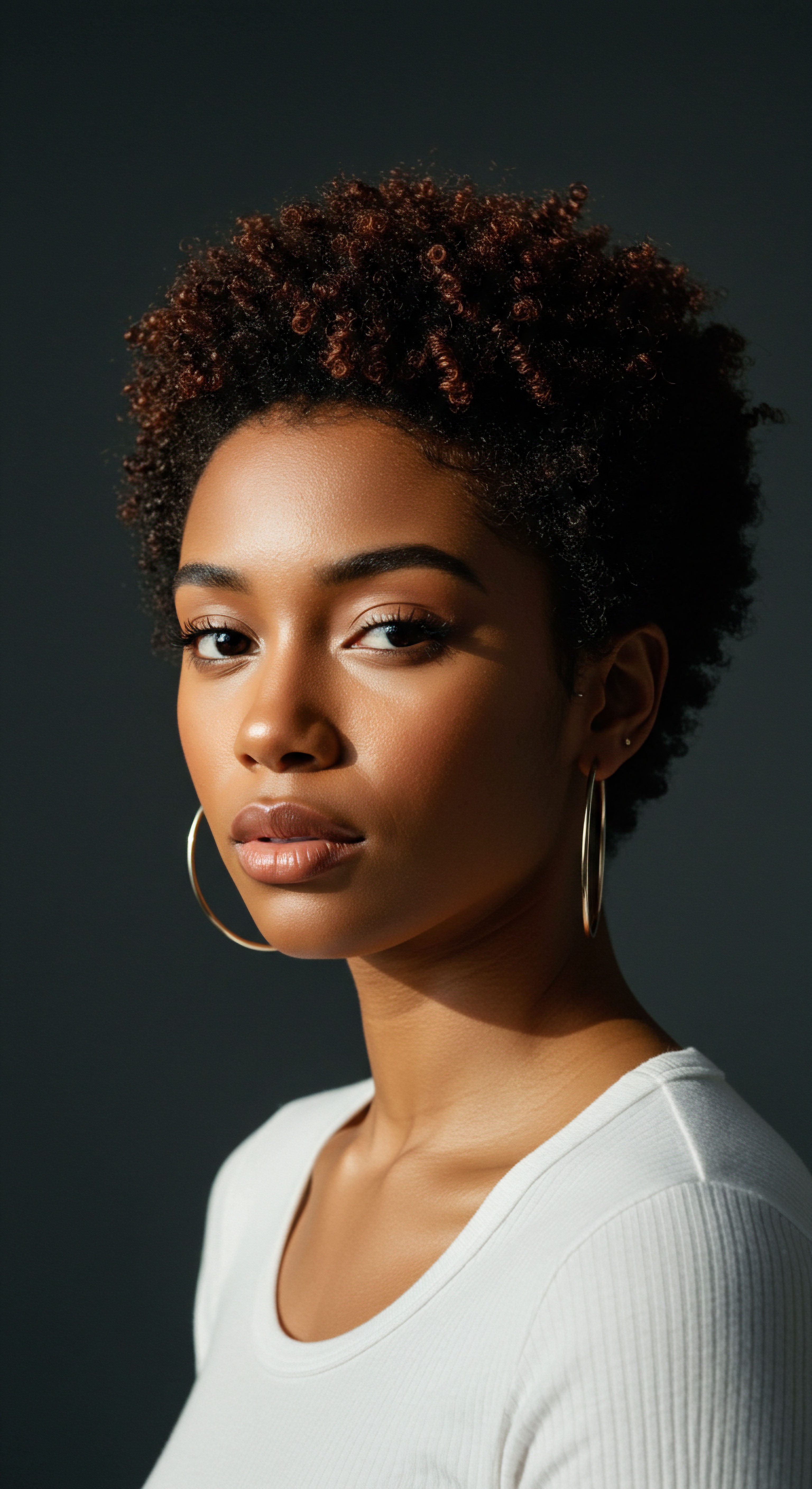
Roots
A quiet inquiry often surfaces when we consider the tender strands that crown our heads ❉ how might the hours of slumber, those seemingly restorative periods, impact the very health of our hair? For many, especially those blessed with textured hair, this question holds a particular weight, stemming from generations of wisdom passed down through families and communities. Our nighttime rituals, steeped in tradition and necessity, have long sought to safeguard hair from the unseen frictions and subtle pressures of sleep. To truly grasp the effectiveness of these nightly practices, we must first look to the fundamental building blocks of hair itself, understanding its delicate architecture and inherent vulnerabilities.
The hair strand, often perceived as a simple filament, possesses a surprisingly complex structure, a marvel of biological engineering. At its heart lies the Hair Follicle, a tiny organ nestled within the skin, responsible for producing the hair shaft. This shaft, the visible part of our hair, consists of three primary layers ❉ the medulla, the cortex, and the cuticle. The medulla, the innermost core, may or may not be present, particularly in finer hair types.
Surrounding this is the Cortex, a dense layer of keratinized cells that gives hair its strength, elasticity, and color. It is here that the majority of hair’s mechanical properties reside. Encasing the cortex is the Cuticle, a protective outer layer composed of overlapping, flattened cells, much like shingles on a roof. These cells, when healthy, lie flat and smooth, reflecting light and shielding the inner cortex from environmental stressors and mechanical damage.
Understanding the cuticle is central to comprehending hair damage. When the cuticle is disrupted, its scales lift, leaving the cortex exposed and vulnerable. This can lead to a host of undesirable outcomes, including dryness, frizz, dullness, and breakage.
Consider the cumulative effect of daily aggressors—environmental pollutants, styling practices, and even the seemingly benign act of resting one’s head on a pillow. Each interaction, however slight, contributes to the potential for cuticle abrasion.
The hair strand, a biological marvel, relies on its outermost cuticle layer to shield its inner strength and maintain its visual luster.
The very nature of textured hair, with its unique curl patterns and varying porosities, presents distinct considerations for care. The helical structure of curly and coily hair means that natural oils produced by the scalp find it more challenging to travel down the hair shaft, often leading to increased dryness at the ends. Furthermore, the points where the hair bends along its curl pattern can be inherent weak spots, more prone to mechanical stress and breakage compared to straight hair. This inherent fragility, a beautiful characteristic of textured hair, underscores the heightened need for protective measures.

What are the Fundamental Components of Hair Structure?
Delving deeper into the microscopic world of hair reveals the intricate interplay of proteins and bonds that grant hair its resilience. Keratin, a fibrous protein, forms the primary constituent of hair. Within the keratin structure, various bonds contribute to hair’s integrity. Disulfide bonds, strong chemical linkages, are responsible for hair’s permanent shape and strength.
Hydrogen bonds, comparatively weaker, are responsible for hair’s temporary shape changes, such as those induced by water or heat. These bonds readily break when hair is wet or heated and reform as it dries or cools, setting a new style.
The density and arrangement of these bonds, along with the shape of the hair follicle, determine the curl pattern. Round follicles tend to produce straight hair, while increasingly oval or hooked follicles yield wavy, curly, and coily patterns. This diversity in follicular shape influences how the cuticle layers lie, and thus, how susceptible the hair is to friction and moisture loss.
A healthy cuticle, regardless of curl pattern, acts as a critical barrier, sealing in moisture and nutrients, and preventing external harm. When this barrier is compromised, the hair’s internal structure becomes exposed, leading to accelerated damage.

How does Hair Type Influence Its Fragility?
Different hair types exhibit varying degrees of susceptibility to damage, largely due to their structural characteristics.
- Straight Hair ❉ Typically has a round cross-section, allowing cuticle scales to lie flat, providing a smooth surface that minimizes friction and retains moisture well.
- Wavy Hair ❉ Possesses an oval cross-section, leading to a slightly raised cuticle in some areas, which can make it more prone to friction than straight hair.
- Curly Hair ❉ Features an elliptical cross-section, and the bends in the curl pattern can cause cuticle scales to lift more frequently, increasing vulnerability to moisture loss and physical damage.
- Coily Hair ❉ Often has a flattened elliptical cross-section with frequent, tight bends. This structure results in numerous points where the cuticle is naturally lifted, making it the most delicate hair type and highly susceptible to dryness and breakage from friction.
The understanding of these foundational elements guides our approach to hair care, particularly when considering the protective measures taken during sleep. Recognizing the inherent fragility of textured hair due to its unique structure underscores the profound value of methods that minimize friction and preserve moisture, aiming to maintain the integrity of that precious cuticle layer.
| Hair Component Hair Follicle |
| Description A small organ within the skin where hair grows. |
| Role in Hair Health Determines hair shape and growth cycle. |
| Hair Component Medulla |
| Description Innermost, often absent, core of the hair shaft. |
| Role in Hair Health May play a role in hair color and strength for some hair types. |
| Hair Component Cortex |
| Description Middle, thickest layer, composed of keratin proteins. |
| Role in Hair Health Provides hair with strength, elasticity, and color. |
| Hair Component Cuticle |
| Description Outermost protective layer of overlapping scales. |
| Role in Hair Health Shields the cortex from damage, retains moisture, and provides shine. |
| Hair Component The interplay of these components defines hair's resilience and vulnerability. |

Ritual
The transition from the day’s activities to the quietude of night presents a unique opportunity for hair restoration, a period when conscious practices can significantly alter the trajectory of strand health. Many of us, in our quiet moments before sleep, seek methods to preserve the integrity of our hair, a testament to the intuitive wisdom that our hair requires protection from the rigors of daily life, even while we rest. This section considers the practical applications of that wisdom, exploring the tangible methods and tools that have gained prominence in nightly hair protection. The aim is to illuminate how these rituals, both ancient and modern, serve to safeguard hair from the mechanical stressors and environmental shifts that occur during sleep.
Nightly hair protection methods fundamentally seek to minimize friction and prevent moisture loss. When we move during sleep, our hair rubs against pillowcases, bedding, or even itself. This constant rubbing can abrade the cuticle, leading to lifted scales, frizz, tangles, and ultimately, breakage.
Cotton pillowcases, with their absorbent and rough fibers, are particularly notorious for creating this friction and drawing moisture from the hair. In contrast, smooth, non-absorbent surfaces offer a gentle glide.
Nighttime hair care, a blend of tradition and science, centers on reducing friction and maintaining hydration to shield delicate strands.
A pivotal study published in the Journal of Cosmetic Dermatology reported that a smooth surface, such as that provided by silk pillowcases, can reduce hair friction by up to 43%. This empirical data underscores the tangible benefit of selecting appropriate sleep surfaces. Beyond pillowcases, protective styles play a central role, particularly for textured hair, by limiting direct exposure to friction and keeping strands aligned.

What are the Most Effective Materials for Sleep Surfaces?
The choice of pillowcase material profoundly impacts hair health during sleep.
- Silk Pillowcases ❉ Widely celebrated for their smooth texture, silk pillowcases permit hair to glide across the surface with minimal friction. This property significantly reduces tangling, breakage, and frizz. Silk also exhibits less absorbency compared to cotton, helping hair retain its natural oils and applied moisture.
- Satin Pillowcases ❉ A synthetic alternative to silk, satin offers similar benefits regarding reduced friction due to its smooth surface. While not as breathable or luxurious as silk, satin pillowcases serve as an accessible and effective option for hair protection.
- Cotton Pillowcases ❉ Though comfortable, cotton’s absorbent nature can draw moisture from hair, leading to dryness. Its coarser fibers also create more friction, potentially causing cuticle damage, tangles, and breakage.
For those with delicate or chemically treated hair, the shift to a silk or satin pillowcase can yield noticeable improvements in hair manageability and overall health. The smooth surface prevents hair from snagging and pulling, preserving the integrity of the hair shaft.

How do Protective Styles Contribute to Nighttime Hair Health?
Protective styles serve as a cornerstone of nighttime hair care, particularly for textured hair. These styles involve securing the hair in a way that minimizes manipulation, reduces exposure to environmental elements, and shields the delicate ends.
Common protective styles suitable for nightly wear include:
- Loose Braids or Twists ❉ Securing hair in one or several loose braids or two-strand twists prevents tangling and reduces friction against sleep surfaces. The looseness is paramount; tight styles can cause tension on the scalp and hairline, potentially leading to traction alopecia.
- Pineapple Method ❉ This involves gathering hair into a very high, loose ponytail or bun on top of the head, resembling a pineapple. This method lifts the hair off the neck and pillow, preserving curl definition and reducing friction, especially for curly hair.
- Buns or Top Knots ❉ A loose bun, positioned at the crown or nape, can keep hair contained and prevent it from sprawling across the pillow.
These styles work by creating a physical barrier between the hair and external stressors, limiting the opportunities for friction and environmental exposure. By keeping the hair contained, they also help to maintain moisture levels, as the hair’s surface area exposed to the air is reduced.
Beyond styling, certain accessories further enhance nightly protection. Bonnets, scarves, and hair wraps made of silk or satin provide an additional layer of defense. They encapsulate the hair, offering a consistent, low-friction environment, irrespective of pillowcase material.
These coverings are particularly beneficial for preserving hairstyles, reducing frizz, and ensuring moisture remains locked within the strands. While direct scientific evidence for bonnets preventing hair loss is still building, their ability to maintain hairstyles and prevent breakage is widely acknowledged.
| Protection Method Silk Pillowcase |
| Primary Benefit Reduced friction, moisture retention |
| Mechanism Smooth surface allows hair to glide, less absorbent material. |
| Protection Method Satin Pillowcase |
| Primary Benefit Reduced friction |
| Mechanism Smooth synthetic surface minimizes drag. |
| Protection Method Loose Braids/Twists |
| Primary Benefit Minimized tangling, reduced friction exposure |
| Mechanism Hair is contained, less direct contact with surfaces. |
| Protection Method Silk/Satin Bonnet |
| Primary Benefit Complete hair enclosure, moisture preservation |
| Mechanism Creates a consistent low-friction environment around all hair. |
| Protection Method These tools and techniques collectively aim to safeguard hair during sleep. |

Relay
Moving beyond the observable effects of nightly hair protection, we encounter a deeper strata of understanding, where the physiological responses of the hair strand intertwine with broader cultural practices and the silent language of our bodies. Can the simple act of preparing hair for rest truly alter its destiny, preventing damage at a cellular level, or does its significance extend into realms of well-being and identity? This section endeavors to connect the threads of scientific inquiry with the rich tapestry of human experience, considering how nightly rituals contribute to hair health in ways that are both measurable and deeply felt.
The very concept of “damage” to delicate strands during sleep transcends superficial concerns. It points to mechanical abrasion at the microscopic level, where the cuticle, the hair’s outermost protective shield, lifts and chips away. This process, often accelerated by friction from coarse sleeping surfaces, leaves the internal cortex vulnerable to dehydration and structural compromise. Repeated nightly assaults can lead to a condition termed “weathering,” a degeneration of the hair shaft that results in brittleness, tangling, and a gummy texture.
Beyond direct mechanical stress, the scalp environment during sleep also plays a role. An unhealthy scalp, potentially due to oxidative stress from resident microbes, can negatively impact pre-emergent hair, affecting the integrity of the hair cuticle even before it fully emerges. This highlights the interconnectedness of scalp health and the long-term vitality of the hair fiber.
The profound impact of nightly hair care extends beyond mere aesthetics, reaching into the microscopic health of each strand and the holistic well-being of the individual.

What Scientific Mechanisms Underpin Effective Nightly Hair Protection?
The efficacy of nightly hair protection methods stems from their ability to mitigate key stressors:
- Friction Reduction ❉ The primary mechanism of silk or satin pillowcases and bonnets. By providing a smooth surface, they reduce the mechanical rubbing that causes cuticle abrasion. This preserves the cuticle’s flattened state, which is crucial for maintaining hair’s smoothness, shine, and structural integrity.
- Moisture Preservation ❉ Unlike absorbent materials such as cotton, silk and satin do not wick away the hair’s natural oils or applied products. This allows the hair to retain its hydration, preventing dryness and brittleness that make strands more susceptible to breakage.
- Reduced Manipulation ❉ Protective styles keep hair contained, minimizing tossing and turning-induced tangles and snags. Less manipulation means less stress on the hair shaft and follicles, reducing the likelihood of breakage and strain.
A study published in the Journal of Cosmetic Dermatology reported that silk’s smooth surface can reduce hair friction by up to 43% compared to cotton. This reduction is significant in preserving the cuticle’s integrity over time. The cumulative effect of nightly movements, averaging around 40 head movements per night for an individual, can lead to substantial damage over months and years if hair is unprotected.

How do Cultural Practices Influence Nightly Hair Care Traditions?
For generations, particularly within Black and mixed-race communities, nightly hair protection has been more than a mere beauty routine; it has been a deeply ingrained cultural practice, a quiet act of self-preservation and care. The use of bonnets, scarves, and specialized wrapping techniques predates modern scientific validation, rooted in ancestral knowledge of hair’s delicate nature and the need to preserve its health and style. These practices often carry a heritage of resourcefulness and ingenuity, born from necessity to protect hair that was historically undervalued or misunderstood in broader society.
The tradition of wrapping hair at night, for instance, has roots in West African cultures, where headwraps and hair coverings served various purposes, including protection, spiritual significance, and social status. This knowledge migrated and adapted, becoming an essential component of Black hair care, particularly in the diaspora. The bonnet, in its contemporary form, stands as a symbol of this continuity, a functional garment that also carries cultural weight, signifying care, pride, and the preservation of identity through hair.
The emphasis on protective styling, often worn for extended periods, also reflects a cultural understanding of hair’s vulnerability. Styles like braids, twists, and cornrows, when installed and maintained with care, shield hair from daily environmental aggressors and reduce the need for constant manipulation. This philosophy extends into nighttime rituals, where these styles are further secured and protected, allowing the hair to rest and recuperate.
The wisdom passed down through families, often through oral tradition, emphasized gentle handling, moisture retention, and minimal friction—principles that modern trichology now affirms. The quiet ritual of preparing hair for sleep, often a moment of personal connection and self-care, transcends the purely functional. It embodies a deep respect for hair as a living extension of self, a repository of heritage, and a canvas of identity.
Furthermore, the choice of hair products and ingredients used in nightly regimens also holds cultural significance. Many communities have long relied on natural oils and butters, understanding their occlusive and moisturizing properties. The scientific community increasingly studies these traditional ingredients, seeking to validate their efficacy in preventing damage and supporting hair health. This intersection of ancestral wisdom and contemporary research reinforces the profound impact of these nightly practices, not just on the hair itself, but on the well-being of individuals and the continuity of cultural heritage.

Reflection
The inquiry into nightly hair protection reveals a rich interplay of science, personal ritual, and cultural legacy. The journey from understanding the microscopic vulnerabilities of a single strand to recognizing the collective wisdom of generations in safeguarding hair is truly enlightening. What we choose to do with our hair each night, whether a simple wrap or a carefully constructed style, is not merely a superficial act; it is a profound gesture of care, a quiet commitment to the vitality of our crown. These practices, rooted in both empirical evidence and deeply held traditions, underscore a fundamental truth ❉ attentive, gentle care during our resting hours contributes significantly to the enduring strength and health of delicate strands, allowing them to flourish with resilience and beauty.

References
- Biddle-Perry, Geraldine, and Mary Harlow, editors. “A Cultural History of Hair, Volume 1 ❉ A Cultural History of Hair in Antiquity.” Bloomsbury Academic, 2018.
- Erdoğan, Bilgen. “Anatomy and Physiology of Hair.” IntechOpen, 2017.
- Heaton, Sarah. “A Cultural History of Hair in the Age of Empire.” Bloomsbury Academic, 2021.
- Markiewicz, Ewa, and Olusola C. Idowu. “Exploring the Use of Natural Ingredients for Textured Hair UV Protection.” Cosmetics, vol. 9, no. 6, 2022.
- Marufu, Agnes. “The Anatomy & Physiology of the Skin & Hair ❉ A brief and concise guide to the structure and function of the skin and hair.” The Wadzie Claire Academy, 2019.
- Montagna, William, and Richard A. Ellis, editors. “The Biology of Hair Growth.” Elsevier, 2013.
- Powell, Margaret K. “A Cultural History of Hair in the Age of Enlightenment.” Bloomsbury Academic, 2021.
- Shetty, V. H. et al. “Protective effect of conditioning agents on Afro ethnic hair chemically treated with thyoglicolate-based straightening emulsion.” Journal of Cosmetic Dermatology, vol. 7, no. 2, 2008, pp. 126-128.
- Tosti, Antonella, and Bianca Maria Piraccini. “Trichology ❉ Diseases of the Hair and Scalp.” CRC Press, 2018. (General trichology reference, not directly from search, but relevant to the content and within the scope of academic books)
- Trueb, Ralph M. “The Value of Hair Care Products.” Journal of Cosmetic Dermatology, vol. 11, no. 4, 2012, pp. 257-261.